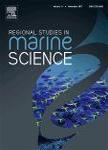版权所有:内蒙古大学图书馆 技术提供:维普资讯• 智图
内蒙古自治区呼和浩特市赛罕区大学西街235号 邮编: 010021

作者机构:Guangdong Ocean Univ Zhanjiang 524088 Peoples R China Southern Marine Sci & Engn Guangdong Lab Zhuhai Zhuhai 519000 Peoples R China Nanjing Univ Informat Sci & Technol Ocean Modeling & Observat Lab Nanjing 210044 Peoples R China
出 版 物:《REGIONAL STUDIES IN MARINE SCIENCE》 (Reg. Stud. Mar. Sci.)
年 卷 期:2021年第45卷
核心收录:
基 金:National Natural Science Foundation of China Natural Science Foundation of Guangdong Province of China [2020A1515010496] National Key R&D Program of China [2018YFD0900906] Southern Marine Science and Engineering Guangdong Laboratory (Zhanjiang) [ZJW-2019-08]
主 题:Decapterus maruadsi Environmental factors Generalized additive models Northern South China Sea Remote sensing
摘 要:Understanding relationships between the spatiotemporal variability of fishery resources and marine environmental variables forms the basis of effective development and utilization of the northern South China Sea (NSCS) fishery resources. Decapterus maruadsi is one important pelagic economic fish which inhabits the coastal warm waters of the NSCS. We examine the spatiotemporal distribution and central of gravity (CoG) of D. maruadsi in the NSCS in spring and autumn from 2015 to 2017 with generalized additive models (GAMs), using fishing trawl data, and remote sensed sea surface temperature (SST), sea surface salinity (SSS), sea surface wind (SSW), chlorophyll a concentration (Chl-a), and the sea level anomaly (SLA) data. During spring D. maruadsi occurs mainly in a small area from 110.5-111 degrees E and 18.25-19.25 degrees N, at about 72 m, SST 24.4-26.8 degrees C, SSS 32.9-34.0 PSU, and SLA -0.04 to 0.04 m. During autumn these ranges shift to 112.25-114.E and 20.25-21.25 degrees N, 62 m, 28.5-28.8 degrees C, and 33.4-34.1 PSU, respectively (D. maruadsi was insensitive to SLA during autumn). Accordingly, we deem the most important variables affecting the distribution of this species to be water depth and SSS in spring and SSS in autumn. CPUE of D. maruadsi was high in autumn and low in spring, with the CoG shifting from spring to autumn northwards by 0.4 degrees N and eastwards by 0.7 degrees E. This shift is likely influenced by this species life habits. Higher D. maruadsi CPUE in 2016 could partly be associated with La Nina and Typhoon climate anomalies. Our results provide a basis for scientific assessment and effective conservation of NSCS fishery resources. (C) 2021 Published by Elsevier B.V.